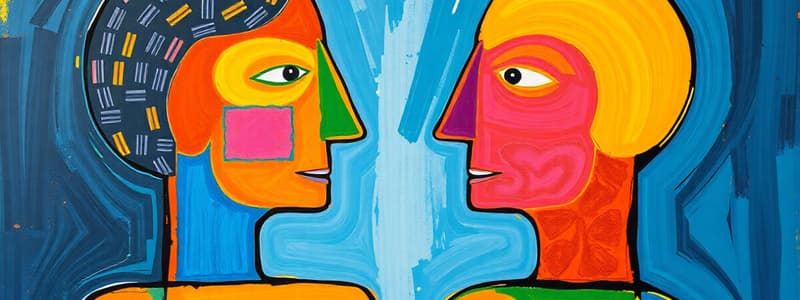Podcast
Questions and Answers
What does person perception primarily refer to?
What does person perception primarily refer to?
- The techniques used in social categorization
- The mental processes used to form opinions and first impressions on people (correct)
- The ability to communicate nonverbally
- The evaluation of physical traits
Which of the following is an example of direct person perception?
Which of the following is an example of direct person perception?
- Hearing an opinion about someone from a friend
- Listening to a podcast discussing someone's achievements
- Reading a profile on social media
- Observing someone's clothing and body language (correct)
What is saliency detection in the context of person perception?
What is saliency detection in the context of person perception?
- The process of forming opinions based on personality traits
- The interpretation of nonverbal cues
- The ability to categorize people into social groups
- The tendency to focus on the most noticeable features of a person (correct)
What does internal attribution focus on when evaluating someone's behavior?
What does internal attribution focus on when evaluating someone's behavior?
What are the three components of attitudes in the tri-component model?
What are the three components of attitudes in the tri-component model?
Which statement best describes a stereotype?
Which statement best describes a stereotype?
What is one potential impact of stereotypes on decision-making?
What is one potential impact of stereotypes on decision-making?
Which limitation of the tri-component model suggests that not all attitude components are necessary?
Which limitation of the tri-component model suggests that not all attitude components are necessary?
Flashcards
Person Perception
Person Perception
The mental process of forming opinions and first impressions of people.
Physical Appearance
Physical Appearance
A factor influencing person perception (clothing, body language, etc.).
Social Categorization
Social Categorization
Grouping people based on shared characteristics (often leading to stereotypes).
Internal Attribution
Internal Attribution
Signup and view all the flashcards
External Attribution
External Attribution
Signup and view all the flashcards
Stereotype
Stereotype
Signup and view all the flashcards
Tri-Component Model of Attitudes
Tri-Component Model of Attitudes
Signup and view all the flashcards
Saliency Detection
Saliency Detection
Signup and view all the flashcards
Study Notes
Social Cognition
- Person Perception: Mental processes used to form first impressions of people.
- Direct: Impressions formed from interacting with the person.
- Indirect: Impressions formed from hearing about the person from others.
- Attributes of Person Perception:
- Physical Appearance: Clothing, looks, and body language influence perceptions of intelligence, warmth, and independence.
- Body Language: Nonverbal communication like eye contact, facial expressions, and posture.
- Saliency Detection: Noticing obvious features that stand out in a group. Can lead to quick judgments, but these judgments may be incorrect.
- Social Categorization (Stereotypes): Grouping people based on shared characteristics.
- Attribution: Conclusions drawn about the causes of a person's behavior.
- Internal Attribution: Attributing behavior to personality, ability, or mood.
- External Attribution: Attributing behavior to situational factors.
- Attitudes: Evaluations of people, objects, or places.
- Tri-Component Model of Attitudes:
- Affective: Emotional response.
- Behavioral: Observable actions.
- Cognitive: Thoughts and beliefs.
- Limitations: Behavioral component may not always accurately reflect attitudes, and some argue only affective and cognitive components are needed.
- Tri-Component Model of Attitudes:
Stereotypes
- Stereotype: A widely held belief or generalization about a group of people.
- Oversimplified and Inaccurate: Stereotypes lead to inaccurate judgments.
- Impact of Stereotypes:
- Decision Making: Can set limits based on stereotypes, shaping goals.
- Interpersonal Interactions: Influence how we interact with others.
Studying That Suits You
Use AI to generate personalized quizzes and flashcards to suit your learning preferences.





